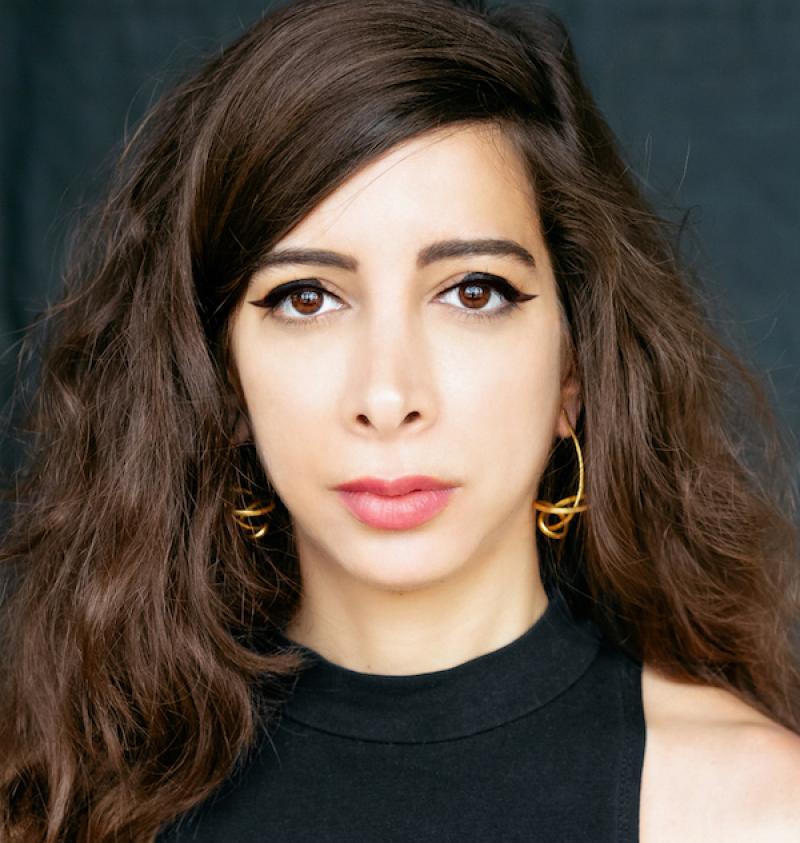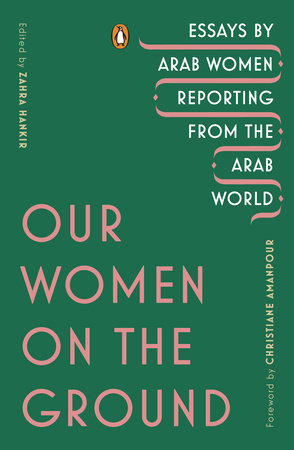Our Women on the Ground: Essays by Arab Women Reporting from the Arab World ed Zahra Hankir review – journalism from the front lines | reviews, news & interviews
Our Women on the Ground: Essays by Arab Women Reporting from the Arab World ed. Zahra Hankir review – journalism from the front lines
Our Women on the Ground: Essays by Arab Women Reporting from the Arab World ed. Zahra Hankir review – journalism from the front lines
Essays by courageous, principled and outspoken female Arab journalists

Many of the women in this pioneering collection of essays have faced unimaginable hardship in their pursuit of truth – persecution by extremist groups as well as the loss of family members and friends. The tone of this collection is, however, best captured by Amira Al Sharif’s photograph of laundry hanging out to dry across a grocer's family home which has been damaged in a coalition bombing in Yemen.
The essays are grouped around loose themes: remembrances, crossfire, resilience, exile and transition. Their content spans countries and conflicts, from the Iraq war to tensions in South Sudan, from life in Palestine to suburban Paris. With a foreword from Christine Amanpour, Chief International Anchor for CNN, the collection of essays includes writing from journalists with significant following in the West such as Hannah Allam, who writes in English for BuzzFeed News in Washington DC, as well as essays from journalists such as Shamael Elnoor and Emam Helal whose audiences are predominantly in their homelands of Sudan and Egypt respectively.
Hankir carefully qualifies the term “Arab women” in her foreword, explaining that though the book centres on women of Arab ancestry, it includes stories from those of other heritage and “many women of the broader Middle East” share similar social, political and cultural challenges. She stresses that by using the “catch all Arab” she does not wish to homogenize the experiences of the 400 million people in the Arab world. On the contrary, she wishes to “illustrate just how rich and wide ranging this area of the world is.”
Hankir introduces the Arab word sahafiya, meaning female journalist, through the story of Ruqia Hussain, a citizen journalist who secretly reported on crimes committed by ISIS from inside occupied Raqqa in Syria. Hussain, who was Kurdish, shared her reports under a pen name on Facebook, gaining a social media following for her coverage at a time when few Western journalists were reporting from the city. In response to death threats, she posted on Facebook “While they will cut off my head, I’ll still have dignity, which is better than living in humiliation.” She was later abducted and murdered by ISIS, along with five other women.
This opening chapter gives a sense of Hankir’s ambition for the book. She celebrates the professional careers of these nineteen sahafiyat and mourns their losses; charts their struggles and invites them to tell their most pressing stories. From Donna Abu Nasr, Dubai Bureau Chief for Bloomberg News, to Lina Attalah, Editor at Mada Masr, a Cairo-based online newspaper, Hankir brings together journalists whose writing attracts diverse audiences to create a multi-dimensional narrative about what it means to be a sahafiya in the Arab world and in the West. Bringing these stories together implies a political act of solidarity in which no single perspective is prioritised – complex political and social issues are discussed with nuance.
 In ‘Just Stop’, Emam Helal uses her own battle with misogyny as a photographer in Cairo to illustrate the barrage of harassment and abuse that women face day to day – from being groped on the train to being deemed unsuitable for marriage for pursuing a career. Asmaa al-Ghoul in ‘Between the Explosions’ explores her mixed feelings about relocating to France after nine members of her family were killed while she was working as a journalist in Palestine. In 'Yemeni Women with Fighting Spirit’, Amira Al Sharif photographs Sadiyaa, a woman who lives on Socotra, a remote, beautiful and contested island, inhabiting a world that “even Yemenis do not see”. Al Sharif wishes to show the world the Yemen she loves through the lens of her camera – a nation of creative, resilient and fascinating people. “Western photographers tend to be drawn to the carnage,” she writes, “but I have continued to seek out the other part of Yemen that is full of life, love and hope.”
In ‘Just Stop’, Emam Helal uses her own battle with misogyny as a photographer in Cairo to illustrate the barrage of harassment and abuse that women face day to day – from being groped on the train to being deemed unsuitable for marriage for pursuing a career. Asmaa al-Ghoul in ‘Between the Explosions’ explores her mixed feelings about relocating to France after nine members of her family were killed while she was working as a journalist in Palestine. In 'Yemeni Women with Fighting Spirit’, Amira Al Sharif photographs Sadiyaa, a woman who lives on Socotra, a remote, beautiful and contested island, inhabiting a world that “even Yemenis do not see”. Al Sharif wishes to show the world the Yemen she loves through the lens of her camera – a nation of creative, resilient and fascinating people. “Western photographers tend to be drawn to the carnage,” she writes, “but I have continued to seek out the other part of Yemen that is full of life, love and hope.”
What makes this collection so compelling are the human moments, set against the backdrop of war. Libyan journalist Heba Shebani, captures the tension in Tripoli that was “so intense and palpable that the idea of healthy dialogue was non-existent,” through an account of how she was recognised from TV in a supermarket and Hannah Allam tells us how she learnt to run holding her abaya, in zigzags to avoid snipers in ‘The Woman question’. In ‘Love and Loss in a Time of Revolution’, Nada Bakri gives a heart rending account of her relationship with her husband, journalist Anthony Shadid, and her grief at his death from a fatal asthma attack in Northern Syria.
In ‘What Normal’, Hwaida Saad describes how as a female journalist for the New York Times she was able to communicate with sources from opposite sides of battle: militants for extremist groups and battalion commanders for the Free Syrian Army. Some of the men wished for the solace of a romantic connection in times of war and struggle and she describes the “love game” they were prepared to play, talking to her over Skype, WhatsApp – some even “crossing the siege” to meet her in Beirut. Donna Abu Nasr describes in ‘An Orange Bra in Riyadh,’ how she choked up at seeing a woman selling a bra for the first time in Jeddah, after the indignity of having to buy underwear from male salesmen.
Many of the women in Our Women on the Ground have prestigious professional careers and reach international audiences, others are key local journalists who are able to influence their respective nations’ news agendas. Though they struggle against different barriers, as “Arab Women” they have a collective power to narrate the experience of women in the Arab world. As Christine Amanpour writes: “Women’s voices are crucial to gaining a full understanding of the story. Without the female perspective, the full picture simply cannot be painted, and often particularly in the Middle East and the Arab world – female protagonists can be given a voice only by other women.”
With this book, Hankir shines a light on the strength of those who have reported on war and womanhood and invites us to “listen to what they have to say”. I urge you to accept her invitation.
Our Women on the Ground: Essays by Arab Women Reporting from the Arab World ed. Zahra Hankir by Penguin Books £9.99
The future of Arts Journalism
You can stop theartsdesk.com closing!
We urgently need financing to survive. Our fundraising drive has thus far raised £49,000 but we need to reach £100,000 or we will be forced to close. Please contribute here: https://gofund.me/c3f6033d
And if you can forward this information to anyone who might assist, we’d be grateful.

Subscribe to theartsdesk.com
Thank you for continuing to read our work on theartsdesk.com. For unlimited access to every article in its entirety, including our archive of more than 15,000 pieces, we're asking for £5 per month or £40 per year. We feel it's a very good deal, and hope you do too.
To take a subscription now simply click here.
And if you're looking for that extra gift for a friend or family member, why not treat them to a theartsdesk.com gift subscription?
more Books
 'We are bowled over!' Thank you for your messages of love and support
Much-appreciated words of commendation from readers and the cultural community
'We are bowled over!' Thank you for your messages of love and support
Much-appreciated words of commendation from readers and the cultural community
 Elizabeth Alker: Everything We Do is Music review - Prokofiev goes pop
A compelling journey into a surprising musical kinship
Elizabeth Alker: Everything We Do is Music review - Prokofiev goes pop
A compelling journey into a surprising musical kinship
 Natalia Ginzburg: The City and the House review - a dying art
Dick Davis renders this analogue love-letter in polyphonic English
Natalia Ginzburg: The City and the House review - a dying art
Dick Davis renders this analogue love-letter in polyphonic English
 Tom Raworth: Cancer review - truthfulness
A 'lost' book reconfirms Raworth’s legacy as one of the great lyric poets
Tom Raworth: Cancer review - truthfulness
A 'lost' book reconfirms Raworth’s legacy as one of the great lyric poets
 Ian Leslie: John and Paul - A Love Story in Songs review - help!
Ian Leslie loses himself in amateur psychology, and fatally misreads The Beatles
Ian Leslie: John and Paul - A Love Story in Songs review - help!
Ian Leslie loses himself in amateur psychology, and fatally misreads The Beatles
 Samuel Arbesman: The Magic of Code review - the spark ages
A wide-eyed take on our digital world can’t quite dispel the dangers
Samuel Arbesman: The Magic of Code review - the spark ages
A wide-eyed take on our digital world can’t quite dispel the dangers
 Zsuzsanna Gahse: Mountainish review - seeking refuge
Notes on danger and dialogue in the shadow of the Swiss Alps
Zsuzsanna Gahse: Mountainish review - seeking refuge
Notes on danger and dialogue in the shadow of the Swiss Alps
 Patrick McGilligan: Woody Allen - A Travesty of a Mockery of a Sham review - New York stories
Fair-minded Woody Allen biography covers all bases
Patrick McGilligan: Woody Allen - A Travesty of a Mockery of a Sham review - New York stories
Fair-minded Woody Allen biography covers all bases
 Howard Amos: Russia Starts Here review - East meets West, via the Pskov region
A journalist looks beyond borders in this searching account of the Russian mind
Howard Amos: Russia Starts Here review - East meets West, via the Pskov region
A journalist looks beyond borders in this searching account of the Russian mind
 Henry Gee: The Decline and Fall of the Human Empire - Why Our Species is on the Edge of Extinction review - survival instincts
A science writer looks to the stars for a way to dodge our impending doom
Henry Gee: The Decline and Fall of the Human Empire - Why Our Species is on the Edge of Extinction review - survival instincts
A science writer looks to the stars for a way to dodge our impending doom
 Jonathan Buckley: One Boat review - a shore thing
Buckley’s 13th novel is a powerful reflection on intimacy and grief
Jonathan Buckley: One Boat review - a shore thing
Buckley’s 13th novel is a powerful reflection on intimacy and grief
 Help to give theartsdesk a future!
Support our GoFundMe appeal
Help to give theartsdesk a future!
Support our GoFundMe appeal

Add comment